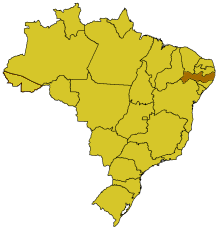Pernambuco
larger image | |
| Statistics | |
|---|---|
| Capital: | Recife |
| Area: | 98,281 km² |
| Inhabitants: | 7,918,344 |
| Pop. density: | 80.6 inh./km² |
| Timezone: | GMT-3 |
| ISO 3166-2: | BR-PE |
| Governor: | Jarbas Vasconcellos |
| Map | |
 | |
Pernambuco is a state of Brazil, located in the northeastern part of the country. To the north are the states of Paraíba and Ceará, to the west is Piauí, to the south are Alagoas and Bahia, and to the east is the Atlantic Ocean.
Geography
Pernambuco has a territory covered mostly by the dry thorny scrub vegetation called caatinga.
History
Pernambuco was first colonized by Portuguese settlers.
In 1534, Dom João III, king of Portugal created the Hereditary Captaincies. Pernambuco, one of these captaincies, was granted to Duarte Coelho. The head of a captaincy was known as Donatario.
Duarte Coelho had arrived at Pernambuco, then known as Nova Lusitânia (New Lusitania), in 1935 and stablished his government in the area on which Olinda was to be founded.
After bloodshed battles against the Caetê indians, which had an alliance with the French, Duarte Coelho founded Olinda at the site of the Marin indian village. This victory made possible estabilize the captaincy and start Portuguese ruling.
The village (vilas) of Olinda (first capital) and Igarassu were founded 1537.
Pernambuco was one of the two only prosperous captaincies (the other was São Vincente), mainly due to the plantation of sugar cane and cotton. With the support of Dutch East India Company, The sugar mills (engenho) were constructed and the sugar industry had greatly developed. In 1612, Pernambuco produced 14,000 tons of sugar; by 1640s, more than 24,000 tons of sugar were exported to Amsterdam.
In 1630, Pernambuco, as well as many Portuguese possession in Brazil, was occupied by the Dutch. Johan Maurits von Nassau, count of Nassau, was appointed as ruler of the Nieuw Holland (Dutch colonization enterprise in Brazil).
Nassau's government built Maritania or Mauristaad (Recife) on delta islands, which is somewhat silimila to Holland's topography. This moved the political focus from Olinda to Recife. The Dutch administration of Nassau's was remarkably noted by advancements in urbanism, culture, and science. The Dutch legacy is still recognizable in Pernambuco's people, accent, and architecture.
Portugal reconquered Pernambuco after Battle of Guararapes in 1654 and Olinda had regained its status of political center. However, Recife remained the commercial /port city.
In 1710 the Mascate War took place in Pernambuco. This conflict put the mascates (traveling salesman) from Recife against the establishment hosted in Olinda and led by the Senhores de Engenho (owners of the sugar mills, literally: sugar mill lords).
Pernambuco was the home for the most important rebellions and insurrections in Brazilian history, especially in the 19th century.
Pernambuco was the site of the brief liberal Praieira revolt in 1848, which was Brazil's response to the European year of failed liberal revolutions. The military officer who put it down was Deodoro da Fonseca, later briefly the first president of the Brazilian republic.
Important Cities
- Recife - State capital.
- Camaragibe
- Caruaru - Main city in the country side.
- Gravatá
- Jaboatão dos Guararapes
- Olinda - Historical site, first capital.
- Paulista
- Petrolina - Prosperous city in the far west of the state
Institutions
External links
- The Dutch in Brazil
- Brazilian Embassy in London
- Recife Guide: information about Recife and Olinda, with photos
Pernambuco is also the name of a tropical tree used for lumber and red dye. Species Caesalpinia echinata. It was also called brazilwood, and gave its name to the country, rather than the other way around.
